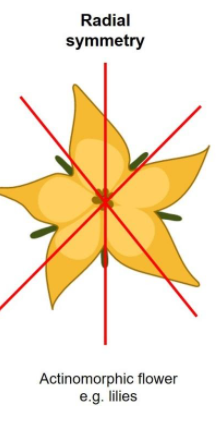
What is radial symmetry?
Answer
579.9k+ views
Hint: When identical parts are arranged in a circular manner around the central point, the symmetry is called radial symmetry. Dividing an organism by an imaginary plane through the central axis yields identical parts.
Complete answer: In the animal kingdom, different types of body symmetry is seen in different animals.
Biological symmetry means the degree of similarity shown by the halves when an organism is divided along an imaginary plane.
An imaginary line drawn from a side through the central point and to the opposite side divides the animal into two symmetrical halves. Animals that are radially symmetrical have many such lines of symmetry.
They have their body parts arranged around a center.
Examples: Animals from Phylum Cnidaria or Coelenterata (jellyfish, corals, and sea anemones), phylum Ctenophora (Comb jellies), and phylum Echinodermata (Sea stars, Sea urchins) show radial symmetry. Some flowers and plants also show radial symmetry.

Additional information: George Cuvier classified animals with radial symmetry in the taxon Radiata, which is now accepted to be a collection of different animal phyla that do not share a single common ancestor.
1. Most radially symmetric animals are symmetrical about an axis expanding from the center of the oral surface, which consists of the mouth, to the center of the opposite end.
2. Animals in the phylum Cnidaria and Echinoderms show radial symmetry, although many sea anemones and some corals within the Cnidaria have bilateral symmetry explained by a single structure, the siphonoglyph.
3. Radial symmetry is readily suitable for sessile animals such as the sea anemone, floating animals such as jellyfish, and slow-moving organisms such as starfish; whereas bilateral symmetry shows locomotion by generating a streamlined body.
Note: Due to the circular arrangement of body parts, these animals do not have distinct anterior or posterior ends but may have the dorsal and ventral sides. Radially symmetrical animals usually lack well-formed, well-developed mesoderm and coelom.
Complete answer: In the animal kingdom, different types of body symmetry is seen in different animals.
Biological symmetry means the degree of similarity shown by the halves when an organism is divided along an imaginary plane.
An imaginary line drawn from a side through the central point and to the opposite side divides the animal into two symmetrical halves. Animals that are radially symmetrical have many such lines of symmetry.
They have their body parts arranged around a center.
Examples: Animals from Phylum Cnidaria or Coelenterata (jellyfish, corals, and sea anemones), phylum Ctenophora (Comb jellies), and phylum Echinodermata (Sea stars, Sea urchins) show radial symmetry. Some flowers and plants also show radial symmetry.

Additional information: George Cuvier classified animals with radial symmetry in the taxon Radiata, which is now accepted to be a collection of different animal phyla that do not share a single common ancestor.
1. Most radially symmetric animals are symmetrical about an axis expanding from the center of the oral surface, which consists of the mouth, to the center of the opposite end.
2. Animals in the phylum Cnidaria and Echinoderms show radial symmetry, although many sea anemones and some corals within the Cnidaria have bilateral symmetry explained by a single structure, the siphonoglyph.
3. Radial symmetry is readily suitable for sessile animals such as the sea anemone, floating animals such as jellyfish, and slow-moving organisms such as starfish; whereas bilateral symmetry shows locomotion by generating a streamlined body.
Note: Due to the circular arrangement of body parts, these animals do not have distinct anterior or posterior ends but may have the dorsal and ventral sides. Radially symmetrical animals usually lack well-formed, well-developed mesoderm and coelom.
Recently Updated Pages
Master Class 12 Business Studies: Engaging Questions & Answers for Success

Master Class 12 Economics: Engaging Questions & Answers for Success

Master Class 12 English: Engaging Questions & Answers for Success

Master Class 12 Maths: Engaging Questions & Answers for Success

Master Class 12 Social Science: Engaging Questions & Answers for Success

Master Class 12 Chemistry: Engaging Questions & Answers for Success

Trending doubts
The pH of the pancreatic juice is A 64 B 86 C 120 D class 12 biology CBSE

Which prominent US inventor was known as the Wizard class 12 social science CBSE

Which state in India is known as the Granary of India class 12 social science CBSE

Give simple chemical tests to distinguish between the class 12 chemistry CBSE

What is virtual and erect image ?

Explain the energy losses in the transformer How are class 12 physics CBSE




